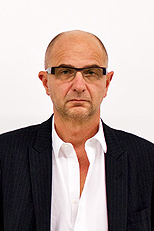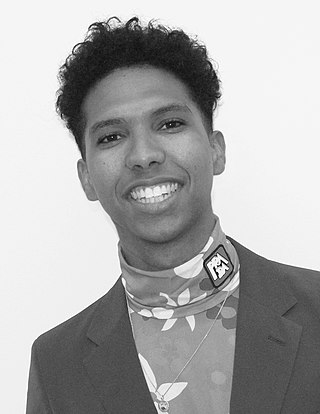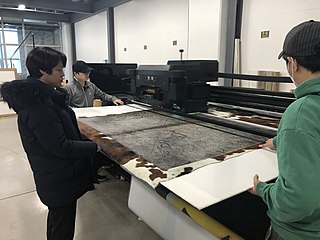Related Research Articles

Yasumasa Morimura is a contemporary Japanese performance and appropriation artist whose work encompasses photography, film, and live performance. He is known for his reinterpretation of recognizable artworks and figures from art history, history, and mass media through his adoption of personas that transcend national, ethnic, gendered, and racial boundaries. Across his photographic and performative series, Morimura's works explore a number of interconnected themes, including: the nature of identity and its ability to undergo change, postcolonialism, authorship, and the Western view of Japan – and Asia, more broadly – as feminine.
Events from the year 1959 in art.
Malick Sidibé was a Malian photographer from a Fulani village in Soloba, who was noted for his black-and-white studies of popular culture in the 1960s in Bamako. Sidibé had a long and fruitful career as a photographer in Bamako, Mali, and was a well-known figure in his community. In 1994 he had his first exhibition outside of Mali and received much critical praise for his carefully composed portraits. Sidibé's work has since become well known and renowned on a global scale. His work was the subject of a number of publications and exhibited throughout Europe and the United States. In 2007, he received a Golden Lion for Lifetime Achievement at the Venice Biennale, becoming both the first photographer and the first African so recognized. Other awards he has received include a Hasselblad Award for photography in 2003, an International Center of Photography Infinity Award for Lifetime Achievement (2008), and a World Press Photo award (2010).

Simon Njami is a writer and an independent curator, lecturer, art critic and essayist.

The Walther Collection is a private non-profit organization dedicated to researching, collecting, exhibiting, and publishing modern and contemporary photography and video art. The collection has two exhibition spaces: the Walther Collection in Neu-Ulm/Burlafingen, in Germany, and the Walther Collection Project Space in New York City.

LagosPhoto Festival is the first international art festival of photography in Nigeria, launched in October 2010. It is organised by the African Artists’ Foundation (AAF) as part of an ongoing project designed to use art in public spaces, as a medium for increasing societal awareness. The festival includes workshops and classes for professional artists, art fairs and indoor and outdoor exhibitions citywide. LagosPhoto is held annually and features emerging photographers alongside established photographers.

Artur Walther is a German-American art collector focused on exhibiting and publishing contemporary photography and video art. A graduate of Harvard Business School, Walther was a General Partner at Goldman Sachs until his retirement in 1994. He began collecting photography in the late 1990s and later established The Walther Collection, which is open to the public at its museum campus in Neu-Ulm, Germany and its Project Space in New York City.
Tomoko Sawada is a Japanese contemporary feminist photographer and performance artist. She has been included in numerous group shows in Japan, Europe and the US. Her first solo exhibition was in 1997 at Japan's Gallery Chat. In 2004 she was awarded the prestigious Kimura Ihei Memorial Photography Award for Young Japanese Photographer as well as the International Center of Photography Infinity Award in the category of Young Photographer.
The practice and appreciation of photographyin the United States began in the 19th century, when various advances in the development of photography took place and after daguerreotype photography was introduced in France in 1839. The earliest commercialization of photography was made in the country when Alexander Walcott and John Johnson opened the first commercial portrait gallery in 1840. In 1866, the first color photograph was taken. Only in the 1880s, would photography expand to a mass audience with the first easy-to-use, lightweight Kodak camera, issued by George Eastman and his company.

Cornelius Marion Battey was an American photographer who shot photographic portraits of black Americans in a pictorialist style. His photograph of black leaders appeared on the cover of the NAACP's magazine The Crisis beginning in the 1910s. He later founded and headed up the photography department at the Tuskegee Institute.
Edson Chagas is an Angolan photographer. Trained as a photojournalist, his works explore cities and consumerism. In his "Found Not Taken" series, the artist resituates abandoned objects elsewhere within cities. Another series uses African masks as a trope for understanding consumerism in Luanda, his home city. Chagas represented Angola at the 2013 Venice Biennale, for which he won its Golden Lion for best national pavilion. He has also exhibited at the Museum of Modern Art and Brooklyn Museum.
Hamidou Maiga is a Malian studio photographer among the region's pioneers in the craft during the postcolonial period. His work was largely unknown in the West prior to his discovery and display in the early 2010s. Maiga's early outdoor portraits from the Niger River region in the late 1950s reflect Mali's period of societal transition from colony to sovereignty. He has exhibited in solo shows in London and Lima, Peru.
Nona Faustine is an American photographer and visual artist who was born and raised in Brooklyn, New York.
Leonce Raphael Agbodjelou, is a Beninese photographer.
Liz Johnson Artur is a Ghanaian-Russian photographer based in London, England. Her work documents the lives of black people from across the African Diaspora. Her work strives to display and celebrate the normal, the vibrant and the subtle nuances of each of these people lives that she encounters. Johnson Artur works as a photojournalist and editorial photographer for various fashion magazines and record labels all over the world, as well as her independent artistic practice. Her monograph with Bierke Verlag was included in the "Best Photo Books 2016" list of The New York Times.

Arthur Jafa is an American video artist and cinematographer.

Tyler Mitchell is an American photographer. He is based in Brooklyn, New York, and is best known for his cover photo of Beyoncé for the cover of Vogue.
Omar Victor Diop is a Senegalese photographer whose conceptually-rich work is exhibited around the world. He lives and works in Dakar and Paris, France.

Chan-Hyo Bae is a visual artist based in London. He earned a Master of Fine Arts from The Slade School of Fine Art in University College of London in Fine Art Media and a Bachelor of Arts in Photography from Kyungsung University in South Korea. He is currently living and working in London.
Ala Kheir is a Sudanese photographer, cinematographer and mechanical engineer. He became known as one of the founders of the Sudanese Photographers Group in Khartoum in 2009 and through international exhibitions of his photographs, as well as for networking and training for photographers in Africa.
References
- ↑ Raz-Russo, Michal. "Samuel Fosso". Encyclopædia Britannica. Retrieved June 6, 2021.
- 1 2 3 Lowery, Rebecca (2008). "Samuel Fosso". Museum of Modern Art.
- 1 2 "'Man of 1,000 faces' wins Deutsche Börse photography prize". The Guardian. May 11, 2023. ISSN 0261-3077 . Retrieved May 11, 2023.
- ↑ Jeune Afrique – Les 50 qui font le Camerou (April 28, 2009) biography (in French)
- 1 2 3 Brigitte Ollier, "Samuel Fosso, le Narcisse noir" Libération, August 3, 2010. (in French)
- ↑ Henley, John (June 19, 2011). "Photographer Samuel Fosso's best shot". The Guardian . Retrieved February 5, 2014.
- 1 2 3 Museum of Art Ulrich, biography Archived January 16, 2014, at the Wayback Machine
- ↑ Taylor, Jessica (June 27, 2002). "Here's looking at me". The Guardian . Retrieved February 5, 2014.
- ↑ Peffer-Engels, John (Winter 1997). "In/sight: African photographers, 1940 to the present". African Arts. Los Angeles. 30 (1): 73–75. ProQuest 220992177.
- 1 2 Hölzl, Ingrid (May 1, 2009). "Self-Portrait/Self-Vision: The Work of Samuel Fosso". Nka: Journal of Contemporary African Art. 2009 (24): 40–47. doi:10.1215/10757163-24-1-40. ISSN 1075-7163. S2CID 194017808.
- ↑ "Samuel Fosso - Self Portrait". International Center of Photography. January 31, 2018.
- ↑ Oguibe, Olu (2015). "Samuel Fosso". Aperture (221): 88–93. ISSN 0003-6420. JSTOR 43825306.
- ↑ Klein, Melanie. "Melanie Klein (2012): "Between history, politics and the self. Photographic portraiture in contemporary art from Africa", in: Jana Gohrisch and Ellen Grünkemeier (Eds.), Listening to Africa. Anglophone African literatures and cultures, Heidelberg, pp. 69-91".
{{cite journal}}: Cite journal requires|journal=(help) - ↑ "Samuel Fosso - Nelson Mandela". Artsy - Purdy Hicks Gallery.
- ↑ Beaumont, Peter (February 6, 2014). "Rescued from war-torn Bangui: photographer Samuel Fosso's life work". The Guardian . Retrieved February 6, 2014.
- ↑ Delay, Jerome (February 6, 2014). "Looted, but Not Lost: An African Artist's Life Work" . Retrieved February 6, 2014.
- ↑ Peter, Bouckaert (February 5, 2014). "Dispatch: Discovering Beauty Amid the Carnage". Human Rights Watch. Archived from the original on May 9, 2021. Retrieved February 6, 2014.
- ↑ "Samuel Fosso: A Glass Ceiling Breaker". Sothebys. Retrieved May 24, 2023.
- ↑ "Samuel Fosso: TATI". Contemporary And (in German). Retrieved May 24, 2023.
- 1 2 3 Falconer, Morgan (2005). "Africa Remix. London, Paris and Tokyo". The Burlington Magazine. 147 (1227): 422–423. ISSN 0007-6287. JSTOR 20074024.
- ↑ "The Lives of Samuel Fosso". Aperture. June 1, 2017. Retrieved May 24, 2023.
- ↑ Sims, Theresa (2019). "Selling Africa: Samuel Fosso's The Chief: He Who Sold Africa to the Colonists". Journal of Contemporary African Art. 44 (1): 52–63. doi:10.1215/10757163-7547442. S2CID 201499149 – via Project MUSE.
- ↑ "Self-portrait and Self-identity in the Works of Samuel Fosso". HASTA. December 9, 2020. Retrieved April 9, 2021.
- ↑ Henley, Jon (June 19, 2011). "Photographer Samuel Fosso's best shot". The Guardian Newspaper.
- ↑ "Samuel Fosso". Purdy Hicks Gallery. 2019.
- ↑ Njami, Simon (2010). "Monography of the Central-African Photographer Samuel Fosso". Revue Noire.
- ↑ "Samuel Fosso - Angela Davis". Artsy - Purdy Hicks Gallery. Archived from the original on February 28, 2021. Retrieved June 6, 2019.
- ↑ Nelson, Steve (Spring 2019). "Nelson Mandela's Two Bodies". Transition (116): 130–142. doi:10.2979/transition.116.130. JSTOR 10.2979/transition.116.130. S2CID 154241514.
- ↑ Bohnacker, Siobhán (September 12, 2014). "The Spirits of Samuel Fosso". The New Yorker. Retrieved June 4, 2020.
- ↑ "The Emperor of Africa | Projects". Art Base Africa. Archived from the original on June 4, 2020. Retrieved June 4, 2020.
- ↑ "Samuel Fosso | The Walther Collection | Artsy". www.artsy.net. Retrieved June 4, 2020.
- ↑ "Samuel Fosso: Emperor of Africa". Aperture Foundation NY. January 28, 2016. Retrieved June 4, 2020.
- ↑ Prince Claus Fund, Awards
- ↑ "Samuel Fosso. Untitled from the series African Spirits. 2008". Museum of Modern Art. Retrieved September 7, 2018.
- ↑ "Samuel Fosso (1962)". Purdy Hicks Gallery.
- ↑ "The Museum of Fine Arts, Houston Collections" . Retrieved June 13, 2020.
- ↑ Tate. "Samuel Fosso born 1962". Tate. Retrieved June 25, 2020.